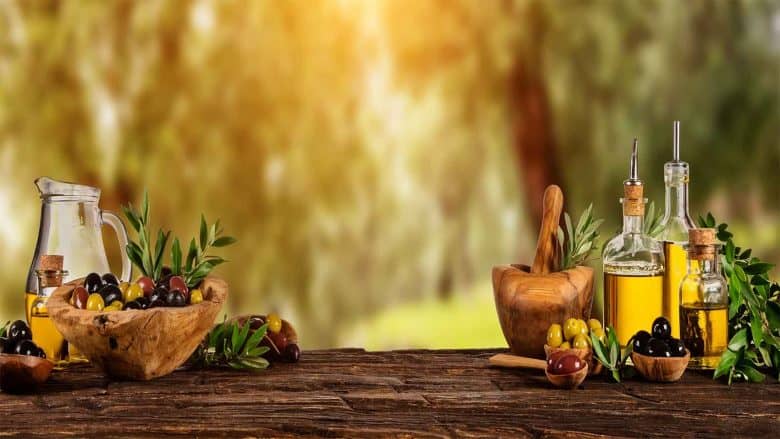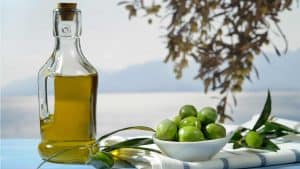It would be a great omission, if we do not talk about the superfoods of our country. Chia seeds, also quinoa and amaranth from Aztecs and Incas are really very nutrient, moreover buckwheat and millet seeds from China and Japan are excellent too.
However Greece is full of food-treasures, very rich in nutritional value that support a balanced dietary model, structured upon the wisdom through the centuries.
The traditional Greek alimony emphasizes on the olive oil, the legumes, the whole wheat cereals, fruits and vegetables that are high content in antioxidants, whereas cuts down the red meat and the processed foods.
We do not need to travel all over the world to find superfoods, we simply have to look around us!

Olive oil or the liquid gold as Omiros referred to, is the leader of the Mediterranean diet. It acts beneficially in all the body functions when it is eaten raw and its acidity is less than 0,8%. It protects the cardiovascular system, lowers the blood pressure, and contributes to the prevention of strokes. Moreover, it reduces the depression risk, regulates the cholesterol levels, and protects from Alzheimer’s disease. It has anti-aging properties and affects positively the growth of the central nervous system.

Dittany is an endemic aromatic low bush of Crete with pharmaceutical properties already known from the ancient times. It grows at the abrupt slopes of canyons and on the steep seaside rocks. In Crete, they use to serve it as a beverage. It is used traditionally as a stop bleeding and healing substance. It has antiseptic and antispasmodic action. They use it for the healing of traumas, as a reliever of the digestive system, and against the flu and cold. It soothes headaches, stomach disorders, toothaches, and abscesses, whereas it helps the good digestion. The chewing of its leaves stops the mouth bad smell.

The Triticum dicoccum or Zea comes from the world ‘Zeidoros’ which in the Greek language means the one who gives life. The ancient town of Athens used to be named ‘Zeidoros’ because its land offered the local grain. The name of the marina of Zeas at Piraeus port originated from the fact that the Zea grains were transported from there to other ports. Its regular cultivation started to be limited at the beginning of the 19th century, against other wheat varieties more valuable. However, during the five last years, the interest in dicoccum wheat grain growth is increasing among Peloponnesos, Thessalia, and Northern Greece. The flour from dicoccum wheat has less gluten whereas it includes a bigger amount of protein, magnesium, and fiber in comparison with other wheat varieties.

The mastic of Chios Island is a unique treasure that is grown only in the Southern part of Chios and nowhere else! It is known from ancient times for its awesome scent and its curative properties. It was the first natural chewing gum in the world, very important for the cleaning and the whitening of the teeth. It is about an aromatic natural resin that originates from the mastic tree. It includes substances with anti-inflammatory, antioxidant anti-bacterial properties. It flavors foodstuffs, pastries and it is an ideal natural preservative. Mastic oil is used in medicine, pharmacy, orthodontics, and perfumery.

Nowadays in Crete, there is the biggest natural forest with carob trees in Europe, it is known as the carob forest of The Three Churches. Carob is eaten pleasantly raw as it is sweet, aromatic, and crispy. It is the natural substitute of chocolate with its own unique taste. Even though it is rich content in sugar, it has very few calories and fats, whereas are gluten and caffeine-free. It can perfectly replace tea or coffee of the people who do homeopathy. It includes calcium, magnesium, iron, phosphorus, potassium and vitamins A, B1, B2 and D. The common medicine suggests hot drink from crushed carobs to the children who suffer from bronchitis or pertussis. The carob honey is a thick liquid that comes when the carobs get to boil. The carob flour is produced by blending the carobs. This flour has a pleasant sweet taste and is used in making bread, cakes, biscuits, and rusks. All the creations with carob flour have an intense dark brown color. The raw carob powder exists for the ones who prefer unprocessed foods and comes from blending and then baking (below 100 degrees) the dried carob lobes without their seeds. It can be used into a recipe that asks for chocolate or cacao powder, replacing them with the same exact amount.

The saffron from Kozani has a deep dark red color and odor intense smell. It is one of the most famous cultivated aromatic and pharmaceutical plants of Greece and important export products. In the market, there is as the hygroscopic mass of clews coming from the dried flower stigmas and as the powder coming from the blending of clews. The domestic production of saffron places Greece in the first trinity of productive countries globally. It is planted in the summer and each fall the precious stigmas are removed by hand and get dried very carefully. Five thousand of stigmas are demanded in order to have one hundred grams of red saffron. This is why saffron is considered one of the most expensive spices and one of the best too. The universal scientific community considers saffron as a drug-treasure for human health, as it has been successfully used in the treatment of various cardiovascular diseases, gynecological and ophthalmic illnesses whereas recent studies prove its usefulness in stress and depression prevention, memory support and dealing with dementia, Parkinson and Alzheimer disease.
They couldn’t be only these! We will continue in a new coming post!
Bibliography: Superfoods of Greece, Dr. Despoina Katsohi
Guide of dietary treatment, Anna Kanellos
Namaste




